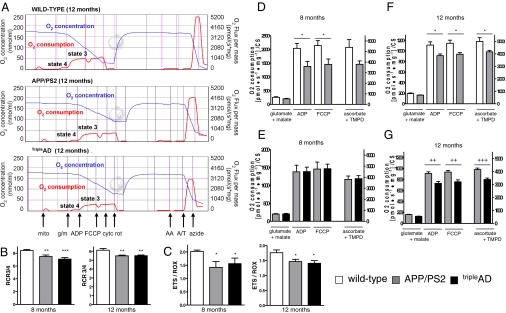Fig. 1.
High-resolution respiratory system reveals a heightened defect in the mitochondrial OXPHOS from brains of tripleAD mice. Measurement of oxygen (O2) flux and consumption in freshly isolated mitochondria from cortical brains of age-matched wild-type, APP/PS2, and tripleAD mice. After detection of endogenous respiration (mito), glutamate+malate (g/m) were added to induce state 4 respiration. ADP stimulated state 3 respiration. After determining coupled respiration, FCCP was added and the maximal respiratory capacity measured in the absence of a proton gradient. Cytochrome c (cyt c) demonstrated mitochondrial membrane integrity. To inhibit activities of complexes I–III, rotenone (rot) and antimycine A (AA) were added. Complex IV activity was stimulated by ascorbate/TMPD (A/T) before terminating mitochondrial respiration by adding sodium azide (azide). O2 consumption was normalized to the corresponding citrate synthase (CS) activity. (A) Representative diagrams of O2 flux and consumption in mitochondria from 12-month-old wild-type, APP/PS2, and tripleAD mice in response to titrated substrates and inhibitors of mitochondrial complexes. (B) RCR3/4 (state3/state4 ratio) representing the mitochondrial coupling state was reduced in 8- and 12-month-old APP/PS2 and tripleAD mice. (C) ETS/ROX ratio, which yields an index of the maximum oxygen consumption capacity of the electron transport system (ETS) relative to the magnitude of residual oxygen consumption (ROX), was reduced in 8- and 12-month-old APP/PS2 and tripleAD mice compared with age-matched wild-type mitochondria. (D) Two-way ANOVA revealed a significant effect of the transgene on the respiratory rates of mitochondria between 8-month-old wild-type and APP/PS2 mice (P < 0.001). (E) No difference was observed in respiration between 8-month-old APP/PS2 and tripleAD mice. (F) At 12 months of age, respiration differed again significantly between wild-type and APP/PS2 (P < 0.001) and (G) between APP/PS2 and tripleAD mice (P < 0.001). (B and C) One-way ANOVA post hoc Tukey's. (D–G) Two-way ANOVA post hoc Bonferroni. *, P < 0.05; **, P < 0.01; ***, P < 0.001 vs. wild-type; ++, P < 0.01; +++, P < 0.001 vs. APP/PS2 (n = 7–12 animals/group).

